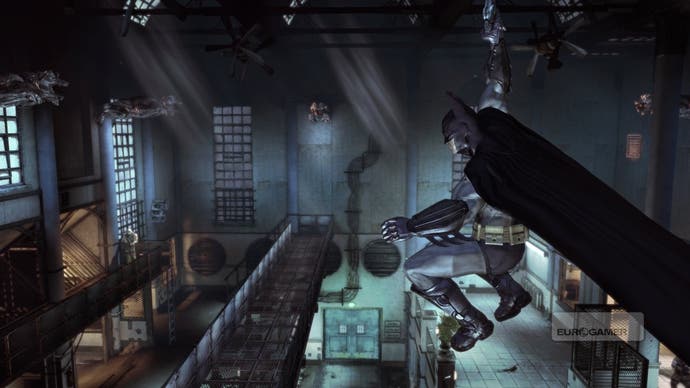Batman: Arkham Asylum
Exclusive hands-on with two new challenge rooms.
On the one hand, there's something maddening about turning up to Eidos' Wimbledon headquarters to play Batman: Arkham Asylum and discovering that it's another two challenge rooms - self-contained, unlockable leaderboard-based action set pieces - that I'm here to play, rather than the single-player story mode itself. But on the other, there's something unusually reassuring about it: I'm desperate to play Batman: Arkham Asylum, a licensed superhero videogame. This may actually be a first.
This preview isn't though, as you will know if you've followed our coverage so far, including last month's hands-on with the first two challenge rooms. This time Eidos is showing off a more developed Batman from later in the game, and I'm guiding him through an "extreme" version of the first Combat room, Intensive Treatment, and an Invisible Predator section unlocked closer to the middle of the single-player campaign.
Relatively little has been said in public about how the story mode plays out, but we can infer a lot from the manner in which the challenge rooms are unlocked and the states in which you face them. There are 16 rooms in total, and some are opened up based on progress, while others become available when you collect a certain number of Joker teeth hidden around Arkham. Staggered between these will be other Brucie bonuses, which develop Batman's battlefield vocabulary through variation, physical enhancement and new gadgets. In other words, there are regular rewards, and they take some digging out.

The challenge rooms, which alternate between Combat and Invisible Predator, are designed for high-scores repeat play, and become more enjoyable as Batman becomes more potent. Whereas last month's trip to Intensive Treatment was a rhythmic but limited procession of twirling strikes, disorientating counters and the occasional leg-break, the Batman facing today's extreme alternative is more sure of himself.
Close combat in third-person games usually goes one of two ways - complex hackandslash, or one-hit-killery - but Arkham Asylum is closer to capoeira, as Batman spins and pirouettes through the Joker's goons, following your analogue direction to a specific target and improvising the encounter based on a catalogue of contextual blows, providing you hit the single attack button within a certain window. Distance isn't a factor, and combos follow, counting up at the side of the screen.

Complication stems from counters, the need to stun certain enemies with your cape-spin, and the availability of multipliers, throws and takedowns once you cross combo thresholds. Throws can be used to toss enemies over barriers or into electric fences, and the more elaborate takedowns bend backs and twist limbs to breaking point, the savagery of the spectacle matched ably by the grace of the animation and the wet crunch of fist and boot on muscle. Gadgets like the batarang and bat-claw trigger-button moves encourage experimentation, which is useful because you accumulate score bonuses for things like variety and avoiding damage. Both Combat and Invisible Predator feed into leaderboards, with global and friends filters, and the best scores will rely on those bonuses.
It's not just Batman with more to say though; the Joker's goon squad is out in greater force, and with new tricks for Intensive Treatment Extreme. Crowd control is ramped up as henchmen start to attack with lead pipes and go for a locked gun cabinet, which sounds a siren. With gunfire tearing Batman down so easily, it's important to keep their hands off it. Health regenerates between enemy waves, but only slightly, and the final opposition line-up gives you a knife-toting Victor Zsasz to worry about, forcing you to reach for cape-spin stun moves rather than traditional counters. Skill prevails, except I didn't have enough of it across half a dozen attempts.








